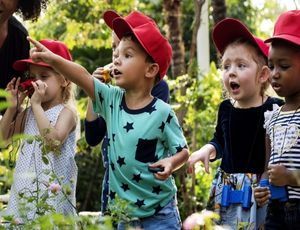Babies are born with 100 billion neurons, nearly twice as many neurons as adults, and in a brain that is half the size. This tremendous number of neurons is necessary for all of the learning the baby will do during the first years of life, especially during the first three years. The metabolic energy they use daily is 60% dedicated to the development of the brain, while adults only use 25% of that energy for their brain. This tells us a lot about the potential of the amazing brain babies have. In this month’s article, we will discuss the concept of the child’s “Absorbent Mind” and how it is related to the environment the child is exposed to.
Dr. Maria Montessori scientifically observed children for many years; she noticed that the brain of children under six years old worked differently than it did later in life. There is intense mental activity that allows the child to learn without any effort. Every stimulus found in the environment is received by the brain and unconsciously stored; this is the characteristic of the “Absorbent Mind.”
With this unique mind, the child will learn the language spoken around him naturally, without any official or professional teaching. The absorbent mind not only stores language, but it also absorbs information about all human activities: movement, music, signing, body language, etc. It might be confusing to think that such a small human being has such a huge potential to learn. This is when we need to understand our responsibility to honor their intelligence. We have to prepare ourselves and the environment; we aim to help and not hinder the process of growth they are having.
Give a child a suitable environment and the effect on his mind will be the same as the effect on his health if we give him well-balanced food. The environment always has two factors, the physical and the human. This last one can affect the other factor significantly. As adults, we aim to observe and identify if the child is having a period of concentration with the physical environment (with any material /object available to him), and if he is, we do not interrupt the moment. Instead, we protect it because we understand that this child is absorbing so much information from this experience, if we step into the picture, the concentration and interest will be lost.
Every interest the child has is valid, even if he has the same interest for many weeks in a row, it deserves respect. Repetition is part of how the brain works, and we need to understand how the natural process of learning continues so we do not interfere with it. Children develop their brains and bodies through movement, and at the same time, concentration, perseverance, and self-discipline are being practiced.
Sense of Order
Young infants and children have an innate desire for order; it allows them to predict what is going to happen and create a secure connection with the environment because they know where everything is, therefore, they own the environment and feel confident and secure about it. Nowadays, it might seem challenging to provide a consistent routine for your child; lifestyles are becoming faster, and it is common for parents to improvise the next part of the day. Still, we must remember children benefit significantly from routines; it satisfies their need for order.
Another way you can satisfy your child’s sense of order is to prepare an environment that does not have many changes in a short period. For instance, avoid changing the layout of furniture very often. Your child enjoys knowing where everything is, and if something suddenly changes, he will notice it and feel disoriented.
Now let’s look into the details of the environment. Have you ever heard the expression “less is more”? Well, it is entirely true, especially for young children with a strong need for order. Having too many toys available makes it difficult to keep order and the thought of organizing them might overwhelm you; it will be almost impossible for your child to be successful at organizing. Try to rotate the toys your child has. Take out just a few of them, and after a couple of weeks, change them for others. You will observe how your child enjoys them differently every time he spends time with them. It will be longer than before since this sense of order with the right number of toys helps him concentrate.
Quote of the Month
“The Child in the Over-Luxurious nursery with too many toys and distractions and the irksomeness of constant supervision is like a young plant that is overwatered -the soil turns sour and the plant becomes sickly.”
Maria Montessori, Maria Montessori Speaks to Parents Volume 21
Item of the Month
Rubber Ball with Protrusions:
It is a non-toxic rubber or plastic sphere that has multiple protrusions. It is initially placed in the baby’s hands and he manipulates it and sucks on the protrusions. An older child will use it to transfer the ball from hand to hand, banging and exploring different ways of using it. Link to buy it at Nienhuis Montessori.com:
https://www.nienhuis.com/us/en/teething-ball-nienhuis-montessori-usa/product/4139/
Video of the Month
This is an amazing video where we can appreciate real neurons making connections with each other. It is a perfect view of what happens in the brain when we allow the absorbent mind to gather information through movement and repetition.
https://www.youtube.com/watch?v=ySgmZOTkQA8



